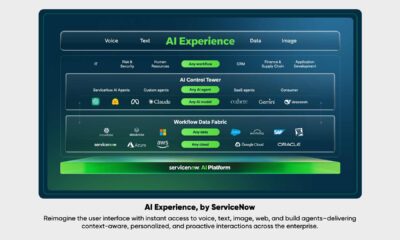Reports
Cohesity Research Highlights a Gap That Puts Businesses and Security Postures at Risk

“While most IT and security operations (SecOps) decision-makers believe they should jointly share the responsibility for their organization’s data security strategy, many of these teams are not collaborating as effectively as possible to address growing cyber threats,” reveals new research commissioned by Cohesity, a data management service provider.
The survey also shows that of those respondents who believe collaboration is weak between IT and security, nearly half of respondents believe their organization is more exposed to cyber threats as a result — and the implications of that could have significant consequences for businesses.
The research is based on an April 2022 survey conducted by Censuswide, of more than 2,000 IT decision-makers and SecOps professionals (split nearly 50/50 between the two groups) from businesses in the United States, the United Kingdom, and Australia — all of whom have a role in the decision-making process for IT or security.
The survey was conducted as nearly three-quarters (74%) of respondents believe the threat of ransomware in their industry has increased over the last year, with nearly half of respondents (47%) saying their organization has been the victim of a ransomware attack in the last six months.
The survey uncovered the following results globally:
- Security should be a shared responsibility: More than four in five (81%) of respondents overall (86% of IT decision-makers and 76% of SecOps) somewhat or strongly agree that IT and SecOps should share the responsibility for their organization’s data security strategy.
- Effective collaboration between IT and security teams is frequently not happening: Almost a third of SecOps respondents (31%) believe the collaboration is not strong with IT, with 9% of those respondents going so far as to call it “weak.” Among IT decision-makers, more than a tenth of respondents (13%), believe collaboration with SecOps is not strong. In total, nearly a quarter (22%) of IT and SecOps respondents overall believe the collaboration between the two groups is not strong.
- The ongoing tech talent shortage is making matters worse: When asked if the talent shortage is impacting the collaboration between IT and security teams, 78% of respondents (77% of IT decision-makers and 78% of SecOps) said, yes, it is having an impact.
Brian Spanswick, chief information security officer, Cohesity, comments, “for too long, many security teams focused primarily on preventing cyber attacks, while IT teams have focused on data protection, including backup and recovery. A complete data security strategy must bring these two worlds together — but in many cases, they remain separate and this lack of collaboration creates significant business risks and can put companies at the mercy of bad actors.”
Reports
Sports fans demand always-on engagement from their favorite teams

Research commissioned by global cloud communications platform Infobip reveals a growing demand among sports fans for always-on, personalized engagement with their favorite teams. The study shows that two-thirds (66%) of fans feel disconnected due to poor club communication, rising to 81% among those under 35. The research of 1,500 football, baseball, cricket, and American football fans across the US, Europe, and India, uncovers widespread frustration with generic, one-way communication and a strong appetite for deeper relationships with clubs beyond game days.
More than 70% of fans want ongoing communication during the off-season, including behind-the-scenes content and personal stories from players. Meanwhile, 82% currently use social media to follow their teams, though many expressed interest in richer, exclusive content through direct messaging and mobile apps.
Many described current engagement as transactional and impersonal, with nearly half feeling like “just a number.” Affordability also emerged as a major barrier — 61% of fans overall said rising costs of subscriptions, tickets, and merchandise are pricing them out of the game.
Driven by a desire to better understand evolving fan needs and explore how technology can reshape sports engagement, the study highlights a significant opportunity for clubs to boost loyalty and fan satisfaction through digital innovation and personalized communication.
Zeid Shubailat, Director at Infobip MENA, said: “Fans across the GCC are seeking a deeper, two-way relationship with their teams that keeps them engaged year-round, not just during major tournaments or match days. The region’s sports scene is rapidly evolving; Saudi Arabia, for example, has invested over $6 billion in its sports industry as part of Vision 2030, resulting in the rise of the football league and significant international sponsorships. Top-tier global racing competitions has also seen tremendous growth, with races now hosted in Saudi Arabia, Bahrain, Qatar, and the UAE, drawing global attention and participation. With advanced technologies like Conversational AI Gamification, sports organizations can deliver highly personalized, real-time fan experiences that foster loyalty and boost participation. Infobip’s AI-driven chatbots on platforms such as WhatsApp empower fans to instantly ask questions, access exclusive content, and receive updates 24/7, helping clubs and leagues across the GCC build stronger, more connected communities.”
Infobip’s platform empowers teams to deliver this next-generation engagement — from real-time match alerts and early ticket sales to seamless personalized support. The result: stronger fan relationships, increased merchandise sales, higher viewership, and new revenue streams.
Infobip is already transforming fan engagement for major sports organizations worldwide. For the MoneyGram Haas F1 Team, Infobip deploys AI-powered chatbots and messaging platforms like WhatsApp to offer real-time interaction, including the upcoming ‘RaceMate’ AI companion and an interactive AI version of F1 driver Oliver Bearman that bring fans closer to the team. In the US, Infobip partners with the Los Angeles Chargers to enhance fan communication through Apple Messages for Business, delivering exclusive content and instant updates.
Read the survey here: https://www.infobip.com/downloads/sports-fan-engagement-report
Hospitality
The State of Hotel Sales, Marketing, and Revenue Optimization Talent

How do you meet the needs of multigenerational workforces? How is the rise of the gig economy and fractional staffing models changing talent sourcing? How do you retain tomorrow’s leaders? How do you unlock the full potential of AI in your organization?
These questions, and many more pieces of the hospitality industry’s talent puzzle, will be discussed at this year’s HSMAI Middle East & Africa Commercial Strategy Conference, taking place on 26-27 November at Conrad Dubai.
Jason Smith, Vice President Marketing Communications at HSMAI, will be decoding new talent dynamics with a deep dive into the HSMAI Foundation’s State of Talent Report 2024, authored by industry expert Dorothy Dowling, and reveal the biggest challenges facing the industry. The report will jumpstart one of the key content tracks at this year’s conference – human capital.
Structured around nine key trends, the annual report investigates issues such as the impact of the 65+ workforce, managing 4-generation talent pools, transforming employee engagement, leveraging AI for productivity, emotional wellness, cross functional teamwork, culture-defining leadership, and gig and fractional talent models.
“Significant developments and emerging shifts are impacting talent within hospitality. In this report, we shine a light on the implications for the industry’s recruitment and retention strategies. We dive into the trends influencing human capital, particularly in sales, marketing, and revenue optimization, and present actionable strategies for creating inclusive, dynamic and forward-thinking workplace environments”, said Jason Smith, Vice President Marketing Communications, HSMAI.
In the lead up to the conference we asked regional industry leaders about their human capital strategies and the opportunities and challenges they see when it comes to talent attraction and retention.
“In a business where people serve people, it is fundamental to lead with culture and understand what team members need to thrive,” said Marie-Louise Ek, Vice President Human Resources – Middle East & Africa, Hilton. “At Hilton, we are committed to building an inclusive workplace driven by purpose, that offers team members opportunities to grow and feel empowered. This requires curiosity, creativity, and the ability to connect every team member to our purpose. We know that every job makes the stay and happy and engaged team members drive our customer experience as well as benefit our owners and the communities where we operate.” Marie-Louise Ek will be hosting one of the Lightening Rounds at the conference titled: ‘Unlocking Successful Commercial Collaboration: The People-First Approach.’
“At Jumeirah we value our people as our greatest asset, fostering an inclusive and empowering workplace where every colleague feels valued and inspired. Committed to career growth, creativity and exceptional standards, we support team success, motivating our people to deliver outstanding service, contribute to communities, and grow as future leaders,” said Jaime Simpson, General Manager Jumeirah Mina Al Salam, who will be hosting a Lightening Round on ‘The Evolving Workplace’ at this year’s conference.
The comprehensive report concludes that the future of the hospitality industry will likely be a combination of advanced technology and the human touch, delivering exceptional experiences for customers and fostering a supportive work environment for employees.
“Now more than ever, sales professionals are looking for work/life balance, and culture is one of the most important deciding factors in choosing their next employer,” states Tammy Gillis, Sales Industry Expert in the report. “Many salespeople are tired of working on property and getting pulled into operations and want full-time remote or hybrid remote positions. They also value training, coaching, and support which the hotel industry does not consistently provide.”
Reports
GCC Trade Set to Grow 5.5% Annually Through 2033, with Total Trade Volume Reaching 2.3T USD, BCG Report Finds

Global trade patterns are transforming significantly as new economic corridors emerge and traditional relationships evolve. According to new research from Boston Consulting Group (BCG), world trade in goods is projected to grow at an average of 2.9% annually through 2033, with the GCC region playing an increasingly pivotal role in connecting major trade routes between East and West.
These insights are among the key findings of BCG’s latest report, “Great Powers, Geopolitics, and the Future of Trade,” which analyzes trade and economic data from more than 150 countries. The report comprehensively analyzes how shifting global trade dynamics will impact regional and international commerce through 2033.
Strong Trade Growth Across Key GCC Corridors
The BCG report reveals a robust outlook for GCC trade, with total trade volume set to reach 2.3T USD by 2033. This growth is supported by significant expansion across multiple trade corridors, with China emerging as the largest growth market at 88B USD (5.7% CAGR), followed by Japan at 46B USD (9.4% CAGR). The analysis shows GCC’s non-hydrocarbon trade will grow by 3.5% annually, highlighting the region’s successful economic diversification efforts.
As global trade patterns shift, the GCC strengthens its position as a critical connector between East and West. This is evidenced by the broader transformation in global trade flows, where China’s trade with the Global South is set to increase by $1.25T and trade between developing nations is projected to grow by $673B through 2033. The GCC’s strategic location and expanding infrastructure position the region to capture value from these evolving trade dynamics.
Rami Rafih, Managing Director and Partner at BCG, said: “The reconfiguration of global trade flows presents a pivotal moment for the GCC. As trade routes transform, the region isn’t just a geographic intermediary but a central orchestrator of new patterns. The GCC’s deliberate investment in capabilities positions it to achieve greater success through developing proactive and risk-based options rather than defaulting to reactionary responses. The key is leveraging this foundation to shape emerging trade corridors, particularly as Global South commerce evolves.”
Global Trade Shifts Create New Opportunities
The report identifies major transformations across key trading regions that will reshape global commerce. While North America solidifies as a resilient trade bloc with US-Mexico trade increasing by $315B by 2033, ASEAN emerges as a significant beneficiary of global shifts with 3.7% annual trade growth. India’s trajectory is particularly notable, with total trade expected to reach $1.8T annually by 2033, driven by its increasing role as a global manufacturing hub.
The growing power of the Global South represents one of the most significant developments in global trade. Representing 18% of global GDP and 62% of the world’s population, these 133 developing nations are set to expand their trade significantly. Annual trade among Global South nations will grow by $673B over the next decade, while trade between the Global South and developed economies is projected to reach $1.67T annually by 2033.
To navigate these shifting trade dynamics and capitalize on emerging opportunities, BCG’s report outlines several key imperatives for business leaders in the region:
Key Recommendations for Business Leaders
- Develop resilient and transparent supply chains by diversifying sourcing strategies and deepening relationships with key suppliers across emerging trade corridors
- Build geopolitical capabilities to better anticipate and respond to changing trade dynamics, particularly in rapidly evolving markets across Asia and Africa
- Expand presence in growth markets, focusing on opportunities in India, China, and other emerging economies where GCC trade is projected to grow significantly
- Embrace smart nearshoring strategies that leverage the GCC’s strategic position between East and West trade routes
- Invest in regional differentiation as global trade fragments, adapting operations and technology to serve diverse market requirements

Cristian Rodriguez-Chiffelle, Partner and Director, Trade, Investment & Geopolitics at BCG, said: “For business leaders, navigating today’s complex trade landscape requires more than agile supply chains – it demands an insights-driven approach to geopolitical shifts. Success will come to those who cultivate deep market intelligence, develop robust scenario planning, and build a portfolio of strategic options, thus building a “geopolitical muscle.” While diversification improves resilience, the real opportunity lies in shaping new trading partnerships that bridge geopolitical divides, and extracts not only challenges but also opportunities arising from geopolitical events.”
-

 Tech News2 years ago
Tech News2 years agoDenodo Bolsters Executive Team by Hiring Christophe Culine as its Chief Revenue Officer
-

 VAR9 months ago
VAR9 months agoMicrosoft Launches New Surface Copilot+ PCs for Business
-

 Tech Interviews2 years ago
Tech Interviews2 years agoNavigating the Cybersecurity Landscape in Hybrid Work Environments
-

 Tech News6 months ago
Tech News6 months agoNothing Launches flagship Nothing Phone (3) and Headphone (1) in theme with the Iconic Museum of the Future in Dubai
-
News10 years ago
SENDQUICK (TALARIAX) INTRODUCES SQOOPE – THE BREAKTHROUGH IN MOBILE MESSAGING
-

 Tech News2 years ago
Tech News2 years agoBrighton College Abu Dhabi and Brighton College Al Ain Donate 954 IT Devices in Support of ‘Donate Your Own Device’ Campaign
-

 VAR1 year ago
VAR1 year agoSamsung Galaxy Z Fold6 vs Google Pixel 9 Pro Fold: Clash Of The Folding Phenoms
-

 Editorial1 year ago
Editorial1 year agoCelebrating UAE National Day: A Legacy of Leadership and Technological Innovation


























